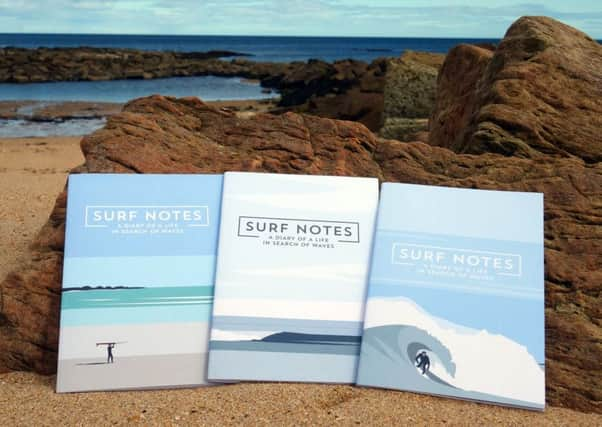Fife designer invites surfers to make like golfers and log their sessions


Surfers, though, are different. Sure, the tiny proportion of the global surfing tribe who ride waves competitively can get just as hung up on performance stats as golfers do, but for the vast majority there’s no obvious need to keep a record of how your last session went. For most people, post-surf analysis can be summed up as follows: “You had fun? Good, you should go surfing again soon. You didn’t have fun? Never mind, you’ll probably have better luck next time.”
Part of the appeal of recreational surfing is the fact that there are no rules, no scores, no winning and losing: it’s just something you do. If you do more of it, you tend to get better at it, and as you get better at it you tend to enjoy it more. You don’t get points or prizes when you get out of the water at the end of a session – just a general feeling of wellbeing as your body basks in an endorphin hit so enormous that, if you could buy it in chemical form, it would almost certainly be illegal.
Advertisement
Hide AdAdvertisement
Hide AdHaving said all that, however, could surfers be missing a trick with their generally lackadaisical approach to their chosen pastime? And could they perhaps benefit from a little more in the way of self-analysis?
This is the direction Fife-based graphic designer Robbie Kerr-Dineen seems to be taking with his new product, Surf Notes. Produced by his company Hasta Inc, these neat little books, with a choice of three stylish, surf-inspired artworks on the cover, are designed to make it easy for surfers to record details of their sessions. At the top of each page there are a few basic stats to fill in: date, time, location, wind speed and direction, swell size, direction and period, and the state of the tide.
Then, underneath, there’s a section simply headed “notes” in which surfers can write up their most recent surf however they choose, focusing either on what the conditions were like, what their surfing was like or both.
How does Kerr-Dineen use this part of his own Surf Notes book? “I try to use it as a reminder about how I surfed, and what I felt,” he says, “almost like a training aid I guess. For example, so often I can find myself staying in the water an hour or so longer than I really should, after the best part of a session – by which point I’m probably tired, cold and less likely to surf well. Remembering that that happened the following session is one thing, but when I know that I’d written a note to myself to get out before that happened is another – it has more resonance.”
Kerr-Dineen accepts that surfing has “always had that ‘in the moment’ thing going on,” and that, for some people, the idea of adding too much analysis to the mix might seem “against the spirit.” So far, however, the feedback from those who have tried Surf Notes seems to be positive (“lots of people seem stoked on the idea, which is amazing”) so perhaps these little books are somehow filling a hole most surfers didn’t even know was there.
Another advantage of keeping a record of your surfs, of course, is that it makes you better able to predict what a particular combination of swell, wind and tide will look like at a particular location.
“One of the key benefits,” says Kerr-Dineen, “is that these books really allow you to get to know a particular spot (or spots) – not just based on what you remember, but what you know and can reference. It’s easy to get so excited that you forget what might have made a particular break work and why. But once you have the detail noted, you’re probably more likely to score it again next time.”
Perhaps the best thing about the Surf Notes concept, though, is the simple fact that it gives surfers something concrete to anchor their memories to. After a while, even the best surfs begin to get a little fuzzy in the mind’s eye, but Surf Notes could be just the thing to keep those favourite mental images sharp for years to come.
To order a copy of Surf Notes, visit www.hastainc.com